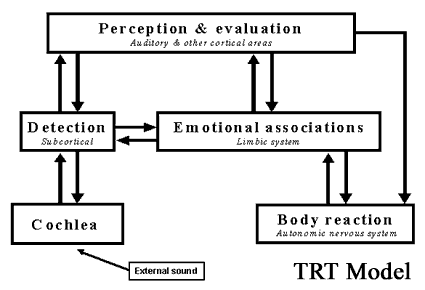By Barry Keate
Barry Keate, has lived with tinnitus over 40 years and has published 150+ research articles on numerous aspects of tinnitus. He is an expert on the condition and a well-known advocate for those with tinnitus.
In the last issue of our newsletter, we discussed the history and recent advances in Tinnitus Masking. This issue will delve into a neurophysiological approach to reducing tinnitus symptoms called Tinnitus Retraining Therapy (TRT).
 Tinnitus Retraining Therapy was developed in the late 1980’s by Pawel Jastreboff, Ph.D., Sc.D. While working at Yale University, Dr. Jastreboff developed his model of tinnitus which postulates the involvement of the limbic (emotional) and autonomic nervous systems in the perception of tinnitus. His research began with the ongoing effort at that time to describe the acoustics of tinnitus.
Tinnitus Retraining Therapy was developed in the late 1980’s by Pawel Jastreboff, Ph.D., Sc.D. While working at Yale University, Dr. Jastreboff developed his model of tinnitus which postulates the involvement of the limbic (emotional) and autonomic nervous systems in the perception of tinnitus. His research began with the ongoing effort at that time to describe the acoustics of tinnitus.
The expectation was that by describing the tinnitus exactly in terms of pitch and loudness, different categories would be established and specific treatments could be applied to each category with predictable outcomes. Instead of the expected results, however, researchers found something completely unexpected and very surprising.
Approximately 75% of all the people who experience tinnitus are not affected by it and they treat tinnitus like any other sound to which they can easily habituate. They hear it similar to the way we hear the sound of the refrigerator in our kitchen, of which we are not normally aware and when we do hear the sound, it is not bothersome.
The researchers found there is no difference in the acoustical characteristics of tinnitus between those who are not bothered by it and those who suffer from it!
This was a profound discovery and led directly to Dr. Jastreboff’s postulation of another cause for the distress caused by tinnitus. The physiological and psychological foundations of his tinnitus model are these:
1. The processing of information occurs on several levels for each sensory system, each level contributing to the final stage when a signal reaches the cortex.
2. The auditory system is closely connected with the part of the brain that controls emotions (limbic system) and the automatic response of the body to danger (autonomic nervous system).
3. Connections within the nervous system are continuously modified, resulting in the enhancement of significant signals and a decrease of neuronal response to irrelevant signals.
4. Sounds that are new, or associated with a negative experience, are treated as significant, evoke an emotional response that triggers the body to “fight or flight.” The repetition of these sounds results in enhancement of their perception and in a resistance of the perception to be suppressed by other signals. The repetition of signals not associated with positive or negative reinforcement results in the disappearance of a response to their presence, i.e., in habituation.
To understand how tinnitus develops, it’s helpful to understand how sound is processed in the auditory pathways. In the absence of noticeable sound levels there is still a high level of neuronal activity in the auditory nerve and pathway, but this activity is random. The nervous system filters out this activity and it is not perceived as sound. When we are exposed to a measurable amount of sound the activity within the auditory system increases and becomes more regular and synchronized. This activity undergoes extensive processing in several subcortical centers within the auditory pathways before reaching the cortex where perception of sound occurs.
This processing of information results in continuous changes of the connections within the brain that are involved in transmitting signals from the ear to the cortex. Repeated activations by a sound not associated with anything of significance will result in decreased activation of the cortical and limbic areas. On the other hand, sound associated with a significant event, particularly related to danger, will be enhanced and will strongly activate the cortical areas and emotional response. Our brain sorts sounds according to their significance, giving important sounds high priority and filtering out, or habituating, insignificant sounds. The rules controlling sorting priorities are in flux and change throughout an individual’s lifetime. TRT postulates that with the proper training one can enhance their perception of some sounds while training their brain to filter out other sounds.

This is the basis of TRT, training the brain to habituate tinnitus sounds and classifying them to represent a neutral, insignificant signal. To achieve this it is necessary to fulfill two basic conditions:
1. Removal of the negative association attached to tinnitus perception.
2. Preservation of tinnitus detection, but not necessarily perception, during treatment.
Signals that induce fear or indicate danger cannot and should not be habituated. We must not habituate sounds that provide warning signals. The decreased negative association of tinnitus is achieved through directive counseling. The patient is taught the basic function of the auditory system and the brain relative to tinnitus. Decreasing the reaction of the autonomic nervous system is a primary goal of the therapy.
The second condition is less obvious but equally important. In order to retrain the neuronal networks, it is imperative that tinnitus be detected. Retraining cannot be achieved for a signal that is masked or undetectable. Thus, for habituation oriented therapy, masking of tinnitus is counterproductive.
Low level, broad band sound is used to facilitate tinnitus habituation. Silence actually enhances tinnitus and patients undergoing TRT are advised to avoid silence. They should immerse themselves in a low level, emotionally neutral sound environment. TRT involves use of in-the-ear sound generators to provide this neutral sound environment. The sound generators are operated at a low enough level that the tinnitus can still be detected. Broad band sound contains all frequencies which gently stimulate the nerve cells in the subconscious networks allowing them to be more easily reprogrammed, or habituated, to no longer notice the tinnitus.
The sound generators are worn continuously and can be taken out for sleep or left in. The cost of the generators is about $2,200.00 to $2,600.00. The cost of directive counseling is added to this. Therapy typically lasts for 12 to 24 months.
It is nearly impossible to conduct a double-blind, placebo controlled study on TRT. It’s difficult to imagine how to construct a placebo that would seem like TRT but be totally ineffective. Because of this there is no wealth of clinical evidence as to its efficacy. Dr. Jastreboff claims that he has treated about 1,000 patients in his clinic at Emory University in Atlanta, GA and that 80% of these have experienced significant improvement. Dr. Jastreboff however does not define or qualify the term “significant improvement.” His website and contact information can be found at http://www.tinnitus-pjj.com/.
Get Free Shipping!
Order now and get free shipping on either the Tinnitus Starter Kit or Combo Pack. Try the doctor recommended products with clinically proven ingredients for tinnitus. No coupon code required.

